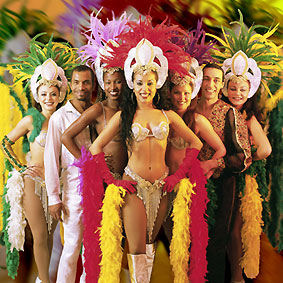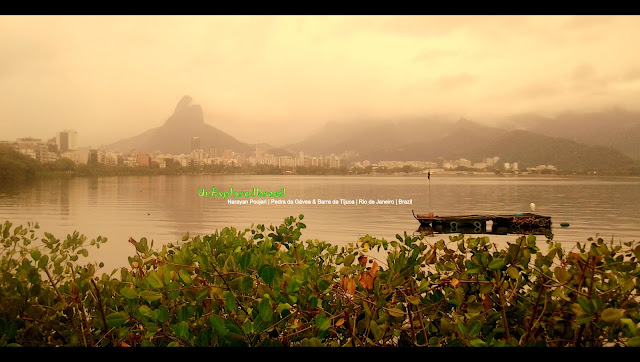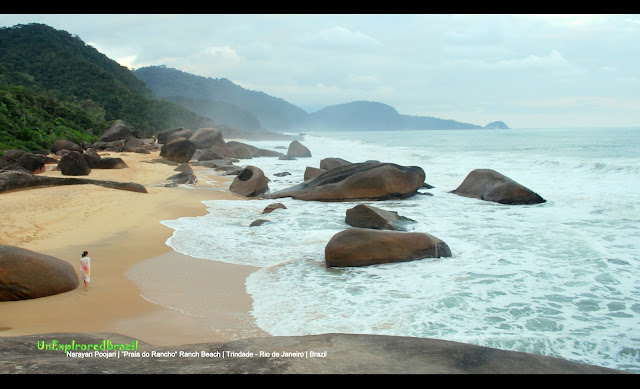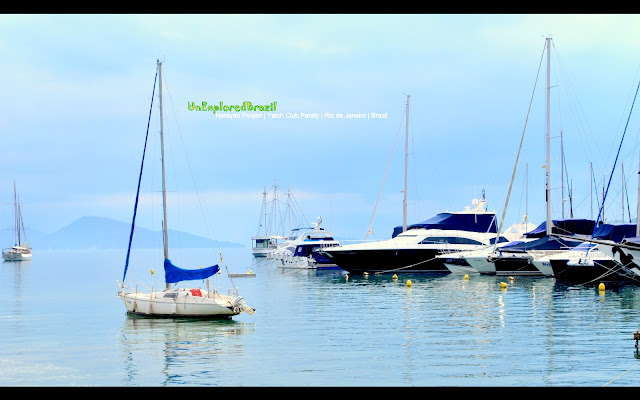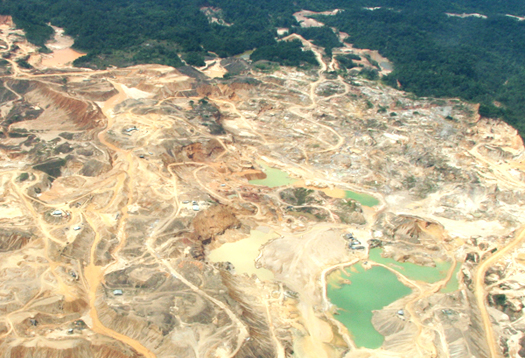It has been a while that I have not posted any blogs, I was bit lazy and too comfortable. I moved to Rio de Janeiro, “Cidade Maravilhoso” (Marvelous
City) , one of the most visited regions in the southern hemisphere. Recently I
took a short drive to near by hill city, the old imperial province, Petropolis. The trip gave me a rare opportunity to grab
stunning and colorful visual behavior of the wonderful nature. Petropolis, sits
on the mountain ranges of “Serra dos
Orgãos”, rich diversity of flora and fauna. Here are some of the vivid colors captured during the trip......
domingo, 24 de fevereiro de 2013
quinta-feira, 18 de outubro de 2012
Favela Rising | Afro-Reggae
Rio de Janeiro, a geographical marvel and the proud
Brazilian tourist spot, is the most visited place in the southern hemisphere. For
decades, Rio de Janeiro city is stamped as the most violent and dangerous
tourist spot in Latin America. Rio city has more than 600 slums (Favela or comunidade),
and has the biggest slum (favela) in the world. Favelas are the burning pots of
Rio's drug related activities and other organized crimes. This documentary is based on a nonviolent cultural
reform through music. The group, Afro-reggae formed in 1993, emerges from the shanty towns and their effort to nail down drug related incidents,
emphasis on education, pulling out the youths out of the drug world. An ex drug
lord Anderson Sá is the mastermind of this ever expanding project.
 The project focuses on education which includes workshops
on dance, recycling, soccer, percussion, self-awareness and more. The group aims
at using music and education to carve the lives of youth and prevent further
expansion of gang involvements. Grupo Cultural AfroReggae believes that through education, there is a greater
likelihood that adolescents will not get caught up in drugs and gang violence.
The band emphasize that the majority of the people in the favela are honest,
hardworking and innocent workers. The documentary takes through series of events
that encountered with Anderson including death threats, mob attacks, surfing
accidents and stage performances.
The project focuses on education which includes workshops
on dance, recycling, soccer, percussion, self-awareness and more. The group aims
at using music and education to carve the lives of youth and prevent further
expansion of gang involvements. Grupo Cultural AfroReggae believes that through education, there is a greater
likelihood that adolescents will not get caught up in drugs and gang violence.
The band emphasize that the majority of the people in the favela are honest,
hardworking and innocent workers. The documentary takes through series of events
that encountered with Anderson including death threats, mob attacks, surfing
accidents and stage performances.
Favela Rising is a 2005 documentary film directed by duo Jeff Zimbalist
and Matt Mochary. It was featured in across the globe and received over 36
international festival awards.
Including Best Documentary Film from the New York
Latino Film Festival and Best Feature documentary from Big Sky
Documentary Film Festival and shortlisted for Oscar
Video Trailer
Visit the websites:
http://favelarising.com/
 The project focuses on education which includes workshops
on dance, recycling, soccer, percussion, self-awareness and more. The group aims
at using music and education to carve the lives of youth and prevent further
expansion of gang involvements. Grupo Cultural AfroReggae believes that through education, there is a greater
likelihood that adolescents will not get caught up in drugs and gang violence.
The band emphasize that the majority of the people in the favela are honest,
hardworking and innocent workers. The documentary takes through series of events
that encountered with Anderson including death threats, mob attacks, surfing
accidents and stage performances.
The project focuses on education which includes workshops
on dance, recycling, soccer, percussion, self-awareness and more. The group aims
at using music and education to carve the lives of youth and prevent further
expansion of gang involvements. Grupo Cultural AfroReggae believes that through education, there is a greater
likelihood that adolescents will not get caught up in drugs and gang violence.
The band emphasize that the majority of the people in the favela are honest,
hardworking and innocent workers. The documentary takes through series of events
that encountered with Anderson including death threats, mob attacks, surfing
accidents and stage performances. Video Trailer
Full documentary
http://favelarising.com/
sexta-feira, 14 de setembro de 2012
2 filhos de Franciso (Two Sons of Franciso)
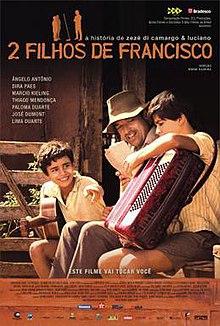 Two sons of Franciso, is the Brazilian film tapping
the history of Brazil's most famous country singers Zezé di Camargo and
Luciano. The 2005 film became the second
most successful in the last 20 years in terms of audience. It grossed $13
million worldwide and $8 million in Brazil. It won Havana Film Festival for
Audience award for Best Film
Two sons of Franciso, is the Brazilian film tapping
the history of Brazil's most famous country singers Zezé di Camargo and
Luciano. The 2005 film became the second
most successful in the last 20 years in terms of audience. It grossed $13
million worldwide and $8 million in Brazil. It won Havana Film Festival for
Audience award for Best Film
A very simple film which reveals the startling history
filled with poverty, struggle, sacrifice, dedication and boundless family
values. The film portrays how the father (Fransciso) of the singers played a
crucial role in their success. Growing up in the farm and later moving into the
city (Goiania, Goias) to pursue a better living was critical in the duos career.
Along with strikingly emotional aspects, the film brings in beautiful
photography, art design and script.
The film received quick responses from the Brazilian
and world audiences for the intense emotional depictions of childhood
struggles, death, success, perseverance and family backings. The music’s from
the duo during the film gave additional flavor.The appearance of the duos parents during a live concert in the last scene of the film was sensational.



sexta-feira, 17 de agosto de 2012
Brazil, a Racial Paradise
Years back during my visit to Brazil I received a warm
red-carpet welcome, and it happened repeatedly. Well, I come from one of the
most racial countries in the world with foundations laid rigidly on religion
and castes. In Brazil, I am being well respected, admired, guided and
entertained by people around me, essential ingredients for surfing around. People
easily recognize me with my bizarre Portuguese accent or the Vibhuthi (the
sacred ash) on my forehead. Brazil is a country which embraces foreigners with
open hands, which is evident from the Christ the Redeemer.
Brazil is a truly multicultural (hybrid) country in
the world. It has 3 major racial stocks -
the American Indian, Negro and European white. An ideal recipe for harmony, a society
with mixed heritage and diversity. Racism is less visible or rather a petty
topic for discussion. It turns out to be a perfect place for humanity to
survive and share.
I have been observing recently! Most of the Brazilian magazines or the TV programs
whether it is a news channel or Novelas
( serials) are packed with white skinned models . If you switch on TV one
will notice what I am talking about, a display limited to white skins and
Brazilian Prados (Brown). I also noticed the limited presence of blacks at work
environment. These findings need to be seriously considered and evaluated.
Is Brazil a racial Paradise or racial haven?
Brazil was the last country to abolish slavery in the
new world (1888). It is home to the 2nd largest black
community in the world after Nigeria. Brazil has more blacks than in USA.
During the slavery period about 8 million Africans were brought into Brazil to
work in the plantations (Sugarcane and later to coffee) and mines. The slaves
were treated heinously and indifferently, but unlike USA they were later freed
or had the right to buy lands or save the other slaves. Also, the Portuguese men
mingled easily with African women and they openly accepted the fatherhood.
A renowned scholar of 20th century Gilberto Freyre in his book, says
" with respect to race relations the Brazilian situation is probably the
nearest approach to paradise to be found anywhere in the world"
After the abolishing of slavery, the government
administered a "whitening" policy by immigrating millions of Europeans.
A catalyst to an overwhelming exchange of colors and resulted in mixed heritage.
As on 2008, PNAD (Pesquisa
Nacional por Amostra de Domicílios) provides the following findings: 48.43% (white), 6.84% (Black), 43.80 %(Pardos/Brown), 0.58% (Asian), 0.28%(Indigenous) and 0.07% (Undeclared)
In the documentary "Brazil a racial paradise” by
Afro-American Professor Henry Louis Jr takes a one-step deeper observation on the
racial discrimination in Latin America. His excellent research brought explicit
information’s curtailing the racism in Brazil. He interviews famous artists,
activists and receives their version of criticism. Zezé Motta, the actor of the
famous 1976 Brazilian film "Xica da Silva", scorns "Her producer did not wanted to cast her in this film, because the
producer felt she was very ugly".
She adds "until recently
blacks were considered ugly". Abdias Nascimento, a civil rights legend
condemns that the governments propagated the message that blacks are treated
equal, which he thinks is a huge lie.
However, the changing governments has seriously
considered the situation and taken actions. Since 2001 more than 70 public
universities have installed racial admission quotas.
On the flip side the historians claims that racial
discrimination is relatively mild compared to the Brazilian epidemic called
social classes. Social Classes are
defined by social status, money, influence and so on. Brazil community basically
forms a pyramid structure, which is typically divided by segments (class A, B,
C, D, E, F). Bottom of the pyramid is
largely constituted by the black community mostly spread across the shanty
towns or inconvenient neighborhoods.
Interesting articles
terça-feira, 14 de agosto de 2012
Uncovering Brazil Rio beaches
Uncovering the hidden beach treasures of Rio de Janeiro. The Atlantic forest descends into vast coastal region,
mostly clean and different soil types. These coast lines are enormous,
spectacularly craved rocks and yet some are hostile because of the rough waves.
During my journey, I
had the privilege to visit many beaches, experiment delicious beach foods, met
different sects of people, music, dance and lots of nature. Each stop in Brazil
gave me surprises and memories. Here are some of the captures during my recent
trip from São Paulo to Rio de Janeiro
segunda-feira, 25 de junho de 2012
Wasteland (Lixo Extraordinário), a captivating story
 "WASTE LAND" IS
A MUST-SEE! A CINDERELLA STORY WITH TRUE
GRIT, A BRILLIANT CAST AND AN IMPROBABLY BIG HEART.” - MINNEAPOLIS STAR
TRIBUNE
"WASTE LAND" IS
A MUST-SEE! A CINDERELLA STORY WITH TRUE
GRIT, A BRILLIANT CAST AND AN IMPROBABLY BIG HEART.” - MINNEAPOLIS STAR
TRIBUNE
Wasteland "Lixo Extraordinário" is a short film by contemporary modern artist Vik Muniz, a Brazilian
based on Brooklyn and directed by Lucy Walker. It was nominated for the Academy
Awards for best documentary feature in 2011, Audience award in Sundance Film festival in 2010, Best documentary in Durban International Film festival (2010) and many.
Muniz uncovers a stoical yet magical story of “Catadores"
(self-designated pickers/scavengers of recyclable materials) from the world’s largest
garbage dump in Jardim Gramacho located in the outskirts of Rio de Janeiro. It is
situated behind the world famous iconic statue "Christ the Redeemer". Every day 7,000 tons of garbage lands at
Jardim Gramacho which accounts 70% of the trash emitted by
Rio de Janeiro. It is recognized for receiving the highest quantity of trash in
any landfill in the world. This landfill is surrounded by a community (“Favela")
Jardim Gramacho, which is home to over 13,000 people whose economy is completely depended on the recyclable material.
Around 3,000 pickers work in landfill with over 1,700 has work contract. The landfill is scheduled to
shut down in 2012.
Muniz was moved by the stunning, inspiring characters and their living conditions. He captured
excellent shots which received wide acknowledgement from the world media. With the collaborators they organized large scale mosaic portraits that are sold out in London and some are exhibited in the Museum of modern art in São Paulo. It is
truly a ground breaking venture by Muniz and crew taking into account the
pickers and their lives. www.wastelandmovie.com
A video trailer




quinta-feira, 21 de junho de 2012
“Amazon” - a riveting and stark escapade in Amazon with Bruce Parry
 "The Amazon
is a metaphor for the world” admits Bruce Parry, UK ex-mariner, ardent adventurist
and presenter. His riveting journey exposed naked truths of the Homo sapiens,
floras and faunas throbbing in Amazon. Although he had prior experiences with
forests and tribes this documentary series gave him grotesque and yet pulsating
revelations. His earlier series “Tribe"
had received immense and immediate global attention.
"The Amazon
is a metaphor for the world” admits Bruce Parry, UK ex-mariner, ardent adventurist
and presenter. His riveting journey exposed naked truths of the Homo sapiens,
floras and faunas throbbing in Amazon. Although he had prior experiences with
forests and tribes this documentary series gave him grotesque and yet pulsating
revelations. His earlier series “Tribe"
had received immense and immediate global attention.
"Amazon with
Bruce Parry", is an exhilarating 6 episode series produced and broadcasted
by BBC. Bruce escapade spanned about 7 months and over 6.800km through the
Amazon. The story begins with the disputed origin of Amazon, at around 5000 meters
high at the Andes Mountain. The droplets melting out of the ice from Andes
makes it the biggest ecological glamor. Bruce spends time with the Alpaca farmers
who live near the origin, Nevado Mismi.
Every year tons of soil swept away from Sahara desert by
wind and are deposited in the Amazon. This process has empowered Amazon for
millions of years, a global commute. Amazon is one of the largest respiratory organ of the earth. It is a jungle of mystery with
thousands of rich diversified species of floras and faunas. Every year a huge
percentage of forest disappears silently and the pace of environmental disaster
is unquestioned.
 For the indigenous, Amazon rainforest is the lifeline
of their existence and for decades they are being haunted by poachers, ranchers
and multi-nationals. Bruce says “It's about the hopes and wishes of
indigenous communities trying to grapple with a mad modern world where they
face losing their language, identity and in some cases, their lives. It's about
people who are so important to the world, who could teach us all so much in
these troubled times. That's what Tribe is to me.”
For the indigenous, Amazon rainforest is the lifeline
of their existence and for decades they are being haunted by poachers, ranchers
and multi-nationals. Bruce says “It's about the hopes and wishes of
indigenous communities trying to grapple with a mad modern world where they
face losing their language, identity and in some cases, their lives. It's about
people who are so important to the world, who could teach us all so much in
these troubled times. That's what Tribe is to me.”
The series clearly portrays the tribe’s resistance to
permit Bruce and his crew into their community. However, he stays with Achuar
people (who had contact with the outside world for less than 40 years) where he
tried the sacred drink Ayahuasca. His lessons from Ayahuasca was moving, his ego has prevented him from seeing the visions. Despite of true efforts, the tribes treats
Bruce with suspicious eyes. Bruce contemplates, the tribes are getting reunited,
alerted to protect and preserve their traditions from intruders.
 The petroleum companies are bustling in the Amazon
basin and the ecology is disrupted. The fishes started to die, soils/land and
fresh water system are polluted from oil spills and other chain of ecological
impacts. On the other hand, some regions of the Amazon are extremely dangerous
and are occupied by deadly coca planters and poachers. Bruce and crew had true
grit to encounter closely the production of cocaine in an undisclosed location
hidden under the woods. They luckily escaped from the raids of the patrolling
helicopter. The nature of this business is prickly and threatening. These planters
take huge risk in planting coca plants for a meager price of $100 which is sold
out for millions in the international market. These planters are poor, however they are part of the chain. Where us the middlemen or dealers mints a huge chunk of money.
The petroleum companies are bustling in the Amazon
basin and the ecology is disrupted. The fishes started to die, soils/land and
fresh water system are polluted from oil spills and other chain of ecological
impacts. On the other hand, some regions of the Amazon are extremely dangerous
and are occupied by deadly coca planters and poachers. Bruce and crew had true
grit to encounter closely the production of cocaine in an undisclosed location
hidden under the woods. They luckily escaped from the raids of the patrolling
helicopter. The nature of this business is prickly and threatening. These planters
take huge risk in planting coca plants for a meager price of $100 which is sold
out for millions in the international market. These planters are poor, however they are part of the chain. Where us the middlemen or dealers mints a huge chunk of money.
After a treacherous and exciting trekking through the
Peruvian Amazon he enters the Brazilian Amazon, he was welcomed by the Carnival
festival at Benjamin Constant. Interestingly Amazon River takes on many names until reaching Brazil.
He had a very memorable and stark experience with the tribes in the Brazilian
Amazon as well. He visits Grota Rica and uncovers a widespread excavation by humans for gold. Bruce winds up his journey in the Para state in Brazil where huge deforestation is undergoing for cattle farming. Here the battle between
the ranchers and indigenous is red hot.
I strongly recommend watching this documentary which
will offer a deep understanding of Amazon rainforest and its living beings
associated with it. The sheer scale of exploitation in Amazon has been a flaming pot for decades and a little has been done. This documentary peeps into the
realities of the indigenous and the scale of wide sprung deforestation, perhaps the
largest exploitation by human beings on the planet. It is an awakening call to the whole humanity.
Follow the links of articles, videos and photos.
Fragile earth, an article on extensive gold mining
Fragile earth, an article on extensive gold mining
An excellent coverage’s about the oil spills in Amazon
http://www.ens-newswire.com/ens/dec2010/2010-12-06-092.html
Assinar:
Postagens (Atom)























